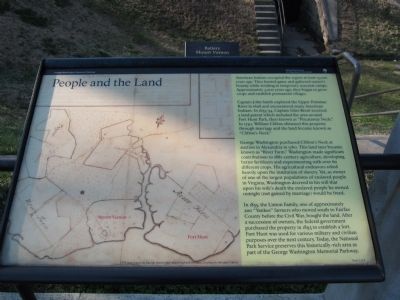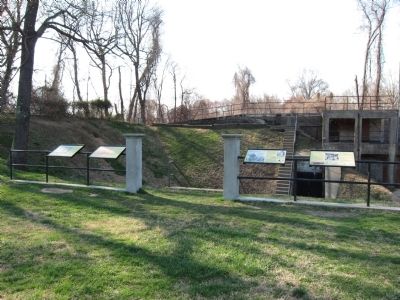Alexandria in Fairfax County, Virginia — The American South (Mid-Atlantic)
People and the Land
George Washington Memorial Parkway
— National Park Service, U.S. Department of the Interior —
Captain John Smith explored the Upper Potomac River in 1608 and encountered many American Indians. In 1653-54, Captain Giles Brent received a land patent which included the area around Fort Hunt Park, then known as "Piscataway Neck." In 1730, William Clifton obtained this property through marriage and the land became known as "Clifton's Neck."
George Washington purchased Clifton's Neck at auction in Alexandria in 1760. This land later became known as "River Farm." Washington made significant contributions to 18th-century agriculture, developing better fertilizers and experimenting with over 60 different crops. His agricultural endeavors relied heavily upon the institution of slavery. Yet, as owner of one of the largest populations of enslaved people in Virginia, Washington decreed in his will that upon his wife's death the enslaved people he owned outright (not gained by marriage) would be free.
In 1855, the Linton Family, one of approximately 200 "Yankee" farmers who moved south to Fairfax County before the Civil War, bought the land. After a secession of owners, the federal government purchased the property in 1893 to establish a fort. Fort Hunt was used for various military and civilian purposes over the next century. Today, the National Park Service preserves this historically-rich area as part of the George Washington Memorial Parkway.
Erected by National Park Service, U.S. Department of the Interior.
Topics and series. This historical marker is listed in these topic lists: African Americans • Exploration • Native Americans • Settlements & Settlers. In addition, it is included in the Former U.S. Presidents: #01 George Washington series list. A significant historical year for this entry is 1608.
Location. 38° 42.912′ N, 77° 3.083′ W. Marker is in Alexandria, Virginia, in Fairfax County. Marker is on Fort Hunt Park Loop, on the left when traveling east. Located in Fort Hunt Park, a unit of the George Washington Memorial Parkway administered by the National Park Service. Touch for map. Marker is in this post office area: Alexandria VA 22308, United States of America. Touch for directions.
Other nearby markers. At least 8 other markers are within walking distance of this marker. Fort Hunt Park (here, next to this marker); Battery Mount Vernon (here, next to this marker); Civilian Conservation Corps (here, next to this marker); In Support of American Defense (here, next to this marker); Beyond What You See Today (within shouting distance of this marker); P.O. Box 1142 (within shouting distance of this marker); WW II: A Battle Fought at Home and Abroad (about 400 feet away, measured in a direct line); Battery Sater (approx. 0.2 miles away). Touch for a list and map of all markers in Alexandria.
Also see . . . Fort Hunt. NPS site. (Submitted on June 5, 2011, by Craig Swain of Leesburg, Virginia.)
Credits. This page was last revised on August 6, 2022. It was originally submitted on March 27, 2011, by Craig Swain of Leesburg, Virginia. This page has been viewed 673 times since then and 14 times this year. Photos: 1. submitted on March 27, 2011, by Craig Swain of Leesburg, Virginia. 2. submitted on June 5, 2011, by Craig Swain of Leesburg, Virginia.

